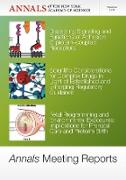- Start
- Annals Meeting Reports - Biomarkers in Nutrition, Revolution in Toxicology, Neuroprotection after Ischemia, Volume 1278
Annals Meeting Reports - Biomarkers in Nutrition, Revolution in Toxicology, Neuroprotection after Ischemia, Volume 1278
Angebote / Angebote:
This Annals volume presents three scholarly meeting reports: (1) Dissecting signaling and functions of adhesion G protein-coupled receptors, (2) Scientific considerations for complex drugs in light of established and emerging regulatory guidance, , and (3) Fetal programming and environmental exposures: implications for prenatal care and preterm birth. G protein-coupled receptors (GPCRs) comprise an expanded superfamily of receptors in the human genome. Adhesion class G protein-coupled receptors (adhesion-GPCRs) form the second largest class of GPCRs. Despite the abundance, size, molecular structure, and functions in facilitating cell and matrix contacts in a variety of organ systems, adhesion-GPCRs are by far the most poorly understood GPCR class. The "6th International Adhesion-GPCR Workshop, " held at the Institute of Physiology of the University of Würzburg on September 6-8, 2012, assembled a majority of the investigators currently actively pursuing research on adhesion-GPCRs, including scientists from laboratories in Europe, the United States, and Asia. The meeting featured the nascent mechanistic understanding of the molecular events driving the signal transduction of adhesion-GPCRs, novel models to evaluate their functions, and evidence for their involvement in human disease. On March 9, 2012, the New York Academy of Sciences brought together experts representing a variety of perspectives--including academic, industrial, regulatory, as well as those from physicians and consumers--to discuss considerations for the non-biological complex drug (NBCD) regulatory approval pathway, given the emerging regulatory guidelines for biosimilars (follow-on biological complex drugs). Plenary sessions addressed the most recent regulatory developments, experimental design, interchangeability, and immunogenicity issues for follow-on versions of complex drugs from the perspective of key audiences, including industry, regulatory agencies, physicians, and consumers. This report summarizes various perspectives on NBCDs and the scientific and regulatory considerations associated with complex drug categories. Sponsored by the New York Academy of Sciences and Cincinnati Children's Hospital Medical Center, with support from the National Institute of Environmental Health Sciences (NIEHS), the National Institute on Drug Abuse (NIDA), and Life Technologies, "Fetal Programming and Environmental Exposures: Implications for Prenatal Care and Preterm Birth" was held on June 11-12, 2012 at the New York Academy of Sciences in New York City. The meeting, comprising individual talks and panel discussions, highlighted basic, clinical, and translational research approaches, and highlighted the need for specialized testing of drugs, consumer products, and industrial chemicals, with a view to the unique impacts these can have during gestation. Speakers also discussed many other factors that affect prenatal development, from genetics to parental diet, revealing the extraordinary sensitivity of the developing fetus. NOTE: Annals volumes are available for sale as individual books or a s a journal. For information on institutional journal subscriptions, please visit http: //ordering.onlinelibrary.wiley.com/subs.asp?ref=1749-6632&doi, =10.111/(ISSN)1749-6632. ACADEMY MEMBERS: Please contact the New York Academy of Sciences directly to place your order (www.nyas.org). Members of the New York Academy of Science receive full-text access to Annals online and discounts on print volumes. Please visit http: //www.nyas.org/MemberCenter/Join.aspx for more information about becoming a member.
Folgt in ca. 15 Arbeitstagen
